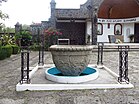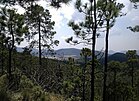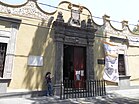
Back Tlalpan (munisipyo) CEB Tlalpan German Τλάλπαν Greek Tlalpan Spanish Tlalpan Basque Tlalpan French Tlalpan Irish Tlalpan Hungarian Delegazione Tlalpan Italian トラルパン Japanese
Tlalpan | |
|---|---|
|
Top: Tlalpan Municipal Palace Middle: San Pedro Apóstol Church, El Ajusco National Park; Bottom: Cuicuilco Archaeological Zone, Old Mint Facility | |
 Tlalpan within Mexico City | |
| Coordinates: 19°18′30″N 99°13′30″W / 19.30833°N 99.22500°W | |
| Country | Mexico |
| Federal entity | Mexico City |
| Established | 1928 |
| Named for | Pre-Columbian city |
| Seat | Plaza de la Constitución No.1-Primer Piso, Tlalpan |
| Government | |
| • Mayor | Alfa González Magallanes (PRD) |
| Area | |
| • Total | 312 km2 (120 sq mi) |
| Elevation | 2,294 m (7,526 ft) |
| Population (2020).[1] | |
| • Total | 699,928 |
| • Density | 2,200/km2 (5,800/sq mi) |
| Time zone | UTC-6 (Central Standard Time) |
| • Summer (DST) | UTC-5 (Central Daylight Time) |
| Postal codes | 14000-14999 |
| Area code | 55 |
| HDI (2020) | |
| Website | [1] |
Tlalpan (Classical Nahuatl: Tlālpan, lit. 'place on the earth', Nahuatl pronunciation: [ˈtɬaːɬpan̥] ) is a borough (demarcación territorial) in Mexico City. It is the largest borough, with over 80% under conservation as forest and other ecologically sensitive area. The rest, almost all of it on the northern edge, has been urban since the mid-20th century. When it was created in 1928, it was named after the most important settlement of the area, Tlalpan, which is referred to as “Tlalpan center” (Tlalpan centro) to distinguish it from the borough.
This center, despite being in the urbanized zone, still retains much of its provincial atmosphere with colonial era mansions and cobblestone streets. Much of the borough's importance stems from its forested conservation areas, as it functions to provide oxygen to the Valley of Mexico and serves for aquifer recharge. Seventy per cent of Mexico City's water comes from wells in this borough.
However, the area is under pressure as its mountainous isolated location has attracted illegal loggers, drug traffickers, and kidnappers; the most serious problem is illegal building of homes and communities on conservation land, mostly by very poor people. As of 2010[update], the government recognizes the existence of 191 of the settlements, which cause severe ecological damage with the disappearance of trees, advance of urban sprawl, and in some areas, the digging of septic pits. The borough is home to one of the oldest Mesoamerican sites in the valley, Cuicuilco, as well as several major parks and ecological reserves. It is also home to a number of semi-independent “pueblos” that have limited self-rule rights under a legal provision known as “usos y costumbres” (lit. uses and customs).
- ^ a b c "Principales Resultados del Censo de Vivienda y Población 2020" (PDF) (in Spanish). Retrieved October 17, 2023.
- ^ "Base de datos del IDS-2020". Consejo de Evaluación de la Ciudad de México.
© MMXXIII Rich X Search. We shall prevail. All rights reserved. Rich X Search





